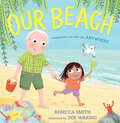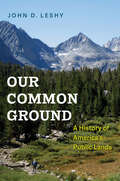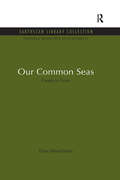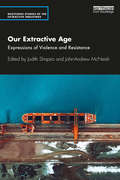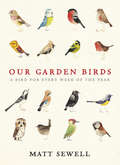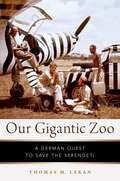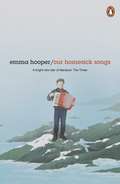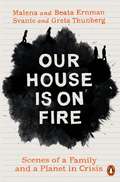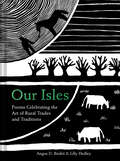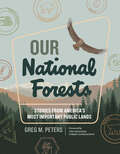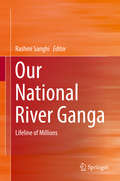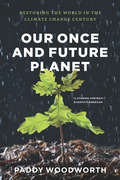- Table View
- List View
Our Beach
by Rebecca SmithA brilliant and heart-warming story about the power of imagination and the special bond between grandparent and grandchild.
Our Changing Menu: Climate Change and the Foods We Love and Need
by Michael P. Hoffmann Carrie Koplinka-Loehr Danielle L. EisemanOur Changing Menu unpacks the increasingly complex relationships between food and climate change. Whether you're a chef, baker, distiller, restaurateur, or someone who simply enjoys a good pizza or drink, it's time to come to terms with how climate change is affecting our diverse and interwoven food system. Michael P. Hoffmann, Carrie Koplinka-Loehr, and Danielle L. Eiseman offer an eye-opening journey through a complete menu of before-dinner drinks and salads; main courses and sides; and coffee and dessert. Along the way they examine the escalating changes occurring to the flavors of spices and teas, the yields of wheat, the vitamins in rice, and the price of vanilla. Their story is rounded out with a primer on the global food system, the causes and impacts of climate change, and what we can all do. Our Changing Menu is a celebration of food and a call to action—encouraging readers to join with others from the common ground of food to help tackle the greatest challenge of our time.
Our Common Ground: A History of America's Public Lands
by John D. LeshyThe little-known story of how the U.S. government came to hold nearly one-third of the nation’s land and manage it primarily for recreation, education and conservation. “A much-needed chronicle of how the American people decided––wisely and democratically––that nearly a third of the nation’s land surface should remain in our collective ownership and be managed for our common good.”—Dayton Duncan, author of The National Parks: America’s Best Idea America’s public lands include more than 600 million acres of forests, plains, mountains, wetlands, deserts, and shorelines. In this book, John Leshy, a leading expert in public lands policy, discusses the key political decisions that led to this, beginning at the very founding of the nation. He traces the emergence of a bipartisan political consensus in favor of the national government holding these vast land areas primarily for recreation, education, and conservation of biodiversity and cultural resources. That consensus remains strong and continues to shape American identity. Such a success story of the political system is a bright spot in an era of cynicism about government. This book is essential reading for anyone who cares about public lands, and it is particularly timely as the world grapples with the challenges of climate change and biodiversity loss.  
Our Common Seas: Coasts in Crisis (Natural Resource Management Set)
by Don HinrichsenMost of the world's population lives on or near the coasts. Every nation not completely landlocked has used the sea as its supposedly self-cleansing garbage dump. Now the effects are being felt. There is not a coast in the world which is not dangerously polluted. Sewage, oil, plastics, industrial effluents, radioactive waste have been added to ungoverned development, all of which are busily destroying otherwise robust inshore eco-systems. Hinrichsen, basing his work on United Nations Environment Programme (UNEP) research and his own extensive travels, has described the situation in the Mediterranean, the Gulf, the Indian Ocean, the South-East Asian Seas and the Eastern Pacific. He covers both the disasters and the growing successes in dealing with them, and he points the way to the sort of international deal needed to rescue a vast resource in danger of complete destruction. His book is both a call to action and a sign of hope. Originally published in 1990
Our Common Seas: Coasts in Crisis (Natural Resource Management Set)
by Don HinrichsenMost of the world's population lives on or near the coasts. Every nation not completely landlocked has used the sea as its supposedly self-cleansing garbage dump. Now the effects are being felt. There is not a coast in the world which is not dangerously polluted. Sewage, oil, plastics, industrial effluents, radioactive waste have been added to ungoverned development, all of which are busily destroying otherwise robust inshore eco-systems. Hinrichsen, basing his work on United Nations Environment Programme (UNEP) research and his own extensive travels, has described the situation in the Mediterranean, the Gulf, the Indian Ocean, the South-East Asian Seas and the Eastern Pacific. He covers both the disasters and the growing successes in dealing with them, and he points the way to the sort of international deal needed to rescue a vast resource in danger of complete destruction. His book is both a call to action and a sign of hope. Originally published in 1990
Our Extractive Age: Expressions of Violence and Resistance (Routledge Studies of the Extractive Industries and Sustainable Development)
by Judith ShapiroOur Extractive Age: Expressions of Violence and Resistance emphasizes how the spectrum of violence associated with natural resource extraction permeates contemporary collective life. Chronicling the increasing rates of brutal suppression of local environmental and labor activists in rural and urban sites of extraction, this volume also foregrounds related violence in areas we might not expect, such as infrastructural developments, protected areas for nature conservation, and even geoengineering in the name of carbon mitigation. Contributors argue that extractive violence is not an accident or side effect, but rather a core logic of the 21st Century planetary experience. Acknowledgement is made not only of the visible violence involved in the securitization of extractive enclaves, but also of the symbolic and structural violence that the governance, economics, and governmentality of extraction have produced. Extractive violence is shown not only to be a spectacular event, but an extended dynamic that can be silent, invisible, and gradual. The volume also recognizes that much of the new violence of extraction has become cloaked in the discourse of "green development," "green building," and efforts to mitigate the planetary environmental crisis through totalizing technologies. Ironically, green technologies and other contemporary efforts to tackle environmental ills often themselves depend on the continuance of social exploitation and the contaminating practices of non-renewable extraction. But as this volume shows, resistance is also as multi-scalar and heterogeneous as the violence it inspires. The book is essential reading for activists and for students and scholars of environmental politics, natural resource management, political ecology, sustainable development, and globalization.
Our Extractive Age: Expressions of Violence and Resistance (Routledge Studies of the Extractive Industries and Sustainable Development)
by Judith Shapiro John-Andrew McNeishOur Extractive Age: Expressions of Violence and Resistance emphasizes how the spectrum of violence associated with natural resource extraction permeates contemporary collective life. Chronicling the increasing rates of brutal suppression of local environmental and labor activists in rural and urban sites of extraction, this volume also foregrounds related violence in areas we might not expect, such as infrastructural developments, protected areas for nature conservation, and even geoengineering in the name of carbon mitigation. Contributors argue that extractive violence is not an accident or side effect, but rather a core logic of the 21st Century planetary experience. Acknowledgement is made not only of the visible violence involved in the securitization of extractive enclaves, but also of the symbolic and structural violence that the governance, economics, and governmentality of extraction have produced. Extractive violence is shown not only to be a spectacular event, but an extended dynamic that can be silent, invisible, and gradual. The volume also recognizes that much of the new violence of extraction has become cloaked in the discourse of "green development," "green building," and efforts to mitigate the planetary environmental crisis through totalizing technologies. Ironically, green technologies and other contemporary efforts to tackle environmental ills often themselves depend on the continuance of social exploitation and the contaminating practices of non-renewable extraction. But as this volume shows, resistance is also as multi-scalar and heterogeneous as the violence it inspires. The book is essential reading for activists and for students and scholars of environmental politics, natural resource management, political ecology, sustainable development, and globalization.
Our Final Warning: Six Degrees Of Climate Emergency
by Mark LynasThis book must not be ignored. It really is our final warning. Mark Lynas delivers a vital account of the future of our earth, and our civilisation, if current rates of global warming persist. And it’s only looking worse.
Our Garden Birds
by Matt SewellIn this beautiful, collectible new volume, street artist Matt Sewell offers his own unique take on 52 of our favourite British garden birds. Since its first appearance in July 2009, Matt's 'Bird of the Week' feature for the Caught by the River website has quickly become a cult hit. His pop-art watercolours are distinctive and enchanting, as are his innovative descriptions, which see great tits 'bossing the other birds around', the 'playful yet shy buoyancy' of bullfinches and the 'improbable' nature of the waxwing ('like a computer-generated samurai finch').With 52 birds, one for each week of the year, this delightful gift book will appeal to bird watching enthusiasts, children and adults, and art and illustration fans alike.
Our Gigantic Zoo: A German Quest to Save the Serengeti
by Thomas M. LekanHow did the Seregenti become an internationally renowned African conservation site and one of the most iconic destinations for a safari? In this book, Thomas M. Lekan illuminates the controversial origins of this national park by examining how Europe's greatest wildlife conservationist, former Frankfurt Zoo director and Oscar-winning documentarian Bernhard Grzimek, popularized it as a global destination. In the 1950s, Grimzek and his son Michael began a quest to save the Serengeti from modernization and "overpopulation" by remaking an imperial game reserve into a gigantic zoo for the earth's last great mammals. Grzimek, well-known to German audiences through his long-running television program, A Place for Animals, used the film Seregenti Shall Not Die to convince ordinary Europeans that they could save nature. Yet their message sidestepped the uncomfortable legacies of German colonial exploitation in the region that had endangered animals and excluded local people. After independence, Grzimek raised funds, brokered diplomatic favors, and convinced German tourists to book travel packages--all to persuade Tanzanian leader Julius Nyerere that wildlife would fuel the young nation's economic development. Grzimek helped Tanzania to create almost a dozen new national parks by 1975, but wooing tourists conflicted with rights of the Maasai and other African communities to inhabit the landscape on their own terms. Grzimek's global priorities eventually clashed with Nyerere's nationalist ones, as a more self-assertive Tanzania resented conservationists' meddling and failed promises. A story that demonstrates the conflicts between international conservation, nature tourism, decolonization, and national sovereignty, Our Gigantic Zoo explores the legacy of the man who portrayed himself as a second Noah, called on a sacred mission to protect the last vestiges of paradise for all humankind.
Our Gigantic Zoo: A German Quest to Save the Serengeti
by Thomas M. LekanHow did the Seregenti become an internationally renowned African conservation site and one of the most iconic destinations for a safari? In this book, Thomas M. Lekan illuminates the controversial origins of this national park by examining how Europe's greatest wildlife conservationist, former Frankfurt Zoo director and Oscar-winning documentarian Bernhard Grzimek, popularized it as a global destination. In the 1950s, Grimzek and his son Michael began a quest to save the Serengeti from modernization and "overpopulation" by remaking an imperial game reserve into a gigantic zoo for the earth's last great mammals. Grzimek, well-known to German audiences through his long-running television program, A Place for Animals, used the film Seregenti Shall Not Die to convince ordinary Europeans that they could save nature. Yet their message sidestepped the uncomfortable legacies of German colonial exploitation in the region that had endangered animals and excluded local people. After independence, Grzimek raised funds, brokered diplomatic favors, and convinced German tourists to book travel packages--all to persuade Tanzanian leader Julius Nyerere that wildlife would fuel the young nation's economic development. Grzimek helped Tanzania to create almost a dozen new national parks by 1975, but wooing tourists conflicted with rights of the Maasai and other African communities to inhabit the landscape on their own terms. Grzimek's global priorities eventually clashed with Nyerere's nationalist ones, as a more self-assertive Tanzania resented conservationists' meddling and failed promises. A story that demonstrates the conflicts between international conservation, nature tourism, decolonization, and national sovereignty, Our Gigantic Zoo explores the legacy of the man who portrayed himself as a second Noah, called on a sacred mission to protect the last vestiges of paradise for all humankind.
Our Homesick Songs: A Novel
by Emma Hooper'A Wes Anderson-esque tale to fall for' Stylist'Warm-hearted and winsomely imaginative' Sunday Times'Elegant and musical' The ListNewfoundland, Canada, 1992. When all the fish vanish from the waters, and the cod industry abruptly collapses, it's not long before the people begin to disappear from the town of Big Running as well. As residents are forced to leave the island in search of work, 10-year-old Finn Connor suddenly finds himself living in a ghost town. There's no school, no friends and whole rows of houses stand abandoned. And then Finn's parents announce that they too must separate if their family is to survive.But Finn still has his sister, Cora, with whom he counts the dwindling boats on the coast at night, and Mrs Callaghan, who teaches him the strange and ancient melodies of their native Ireland. That is until his sister disappears, and Finn must find a way of calling home the family and the life he has lost. This is an enchanting tale about a fading town and a boy who would do anything to save his family
Our House is on Fire: Scenes of a Family and a Planet in Crisis
by Greta Thunberg Malena Ernman Beata Ernman Svante ThunbergThe profoundly moving story of how love, courage and determination brought Greta Thunberg's family back from the brink'Urgent, lucid, courageous ... a must-read message of hope ... It is a glimpse of a saner world' David Mitchell, GuardianThis is the story of a happy family whose life suddenly fell apart, never to be the same again. Of two devoted parents plunged into a waking nightmare as their eleven-year-old daughter Greta stopped speaking and eating, and her younger sister struggled to cope.They desperately searched for answers, and began to see how their children's suffering reached far beyond medical diagnoses. This crisis was not theirs alone: they were burned-out people on a burned-out planet. And so they decided to act.Our House is on Fire shows how, amid forces that tried to silence them, one family found ways to strengthen, heal, and gain courage from the love they had for each other - and for the living world. It is a parable of hope and determination in an emergency that affects us all.
Our Isles: Poems Celebrating The Art Of Rural Trades And Traditions
by Angus D. Birditt Lilly HedleyFrom baker, beekeeper and birdwatcher to falconer, farrier and forager, join poet Angus and printmaker Lilly as they explore the British Isles, uncovering and celebrating our crafts and traditions.
Our National Forests: Stories from America's Most Important Public Lands
by Greg M. PetersA complete look at America&’s National Forests—their triumphs, challenges, controversies, and vital programs—and the dedicated people who keep them alive.
Our National Park Policy: A Critical History (RFF Forests, Lands, and Recreation Set)
by John IsneA legislative and administrative history on the social, cultural, and intellectual significance of the national park idea. Originally published in 1961
Our National Park Policy: A Critical History (RFF Forests, Lands, and Recreation Set)
by John IsneA legislative and administrative history on the social, cultural, and intellectual significance of the national park idea. Originally published in 1961
Our National Parks: A campaign for the preservation of wilderness (John Muir: The Eight Wilderness-Discovery Books)
by John Muir‘Any fool can destroy trees. They cannot run away ... God has cared for these trees ... but he cannot save them from fools – only Uncle Sam can do that.’First published in 1901, Our National Parks is possibly the bestselling book of Muir’s wilderness-discovery titles and was certainly the most influential published in his lifetime, with a strong focus on the preservation of forest reserves.With a strong political tone and shrewd, subtle manoeuvring, Muir uses Our National Parks to persuade his readership of the necessity of nature and national parks for human recreation and more importantly for health and wellbeing, as well as the – in his mind – obvious need for preservation of wild ecosystems.Cannily he counterbalances this with the acknowledgement of the need for timber and irrigation systems, in order that his message is taken seriously; Muir’s passion is portrayed so vividly and flamboyantly that without his learned political and scientific reinforcement, he could be misconstrued as purely a radical and eccentric nonconformist. However, the two combined result in an engaging and convincing argument that these landscapes are our ‘natural home’, and ‘fountains of life’.As Muir expert Terry Gifford observes in the foreword, ‘Muir’s tone can shift in this book from seductive persuasion, to charming details of creatures, flora and landscapes, to scientific information, to trail guide, to religious uplift, to a final political speech of startling ferocity.’John Muir’s strategic yet genuine and beautiful conservationist essays were a first at the time of publication, and are still highly applicable to our attitudes and lifestyles today in the twenty-first century.
Our National River Ganga: Lifeline of Millions
by Rashmi SanghiThere is a plethora of information available on the river Ganga in the form of books, blogs, articles, websites, videos. Unfortunately, most of the information about this famous river is in a scattered form and reproduced from unverified sources. This contributed volume is the first multi-author volume publication on this subject. The River Ganga includes a vast array of topics written by several authors of distinction. Topics include; hydrology, tributaries, water uses, and environmental features such as river water quality, aquatic and terrestrial flora/fauna, natural resources, ecological characteristics, sensitive environmental components and more. Part I gives a basic introduction of the Ganga river. The existing data and available information from various sources has been compiled in a pictorial fashion in the form of cmaps. Its cultural importance with changing times is also discussed. Part II looks at the rich biodiversity of the Ganga Basin. It gives a detailed description of the major floral and faunal biodiversity with special emphasis on the national aquatic animal dolphin and Sunderbans, the largest mangrove wetland in the world. Part III examines ‘The Ganga Water as it flows’. It focuses on the water quality as well as its associated challenges. Part IV looks at the complexities of issues confronting the river ‘Ganga in changing times’ be it snowmelt runoff, river bank erosion hazards and hydropower assessments; how the factors of population, poverty and pollution contribute to the fate of the river. Part IV touches on economic aspects derived from the river such as business opportunities and tourism.
Our Oldest Task: Making Sense of Our Place in Nature
by Eric T. Freyfogle“This is a book about nature and culture,” Eric T. Freyfogle writes, “about our place and plight on earth, and the nagging challenges we face in living on it in ways that might endure.” Challenges, he says, we are clearly failing to meet. Harking back to a key phrase from the essays of eminent American conservationist Aldo Leopold, Our Oldest Task spins together lessons from history and philosophy, the life sciences and politics, economics and cultural studies in a personal, erudite quest to understand how we might live on—and in accord with—the land. Passionate and pragmatic, extraordinarily well read and eloquent, Freyfogle details a host of forces that have produced our self-defeating ethos of human exceptionalism. It is this outlook, he argues, not a lack of scientific knowledge or inadequate technology, that is the primary cause of our ecological predicament. Seeking to comprehend both the multifaceted complexity of contemporary environmental problems and the zeitgeist as it unfolds, Freyfogle explores such diverse topics as morality, the nature of reality (and the reality of nature), animal welfare, social justice movements, and market politics. The result is a learned and inspiring rallying cry to achieve balance, a call to use our knowledge to more accurately identify the dividing line between living in and on the world and destruction. “To use nature,” Freyfogle writes, “but not to abuse it.”
Our Oldest Task: Making Sense of Our Place in Nature
by Eric T. Freyfogle“This is a book about nature and culture,” Eric T. Freyfogle writes, “about our place and plight on earth, and the nagging challenges we face in living on it in ways that might endure.” Challenges, he says, we are clearly failing to meet. Harking back to a key phrase from the essays of eminent American conservationist Aldo Leopold, Our Oldest Task spins together lessons from history and philosophy, the life sciences and politics, economics and cultural studies in a personal, erudite quest to understand how we might live on—and in accord with—the land. Passionate and pragmatic, extraordinarily well read and eloquent, Freyfogle details a host of forces that have produced our self-defeating ethos of human exceptionalism. It is this outlook, he argues, not a lack of scientific knowledge or inadequate technology, that is the primary cause of our ecological predicament. Seeking to comprehend both the multifaceted complexity of contemporary environmental problems and the zeitgeist as it unfolds, Freyfogle explores such diverse topics as morality, the nature of reality (and the reality of nature), animal welfare, social justice movements, and market politics. The result is a learned and inspiring rallying cry to achieve balance, a call to use our knowledge to more accurately identify the dividing line between living in and on the world and destruction. “To use nature,” Freyfogle writes, “but not to abuse it.”
Our Oldest Task: Making Sense of Our Place in Nature
by Eric T. Freyfogle“This is a book about nature and culture,” Eric T. Freyfogle writes, “about our place and plight on earth, and the nagging challenges we face in living on it in ways that might endure.” Challenges, he says, we are clearly failing to meet. Harking back to a key phrase from the essays of eminent American conservationist Aldo Leopold, Our Oldest Task spins together lessons from history and philosophy, the life sciences and politics, economics and cultural studies in a personal, erudite quest to understand how we might live on—and in accord with—the land. Passionate and pragmatic, extraordinarily well read and eloquent, Freyfogle details a host of forces that have produced our self-defeating ethos of human exceptionalism. It is this outlook, he argues, not a lack of scientific knowledge or inadequate technology, that is the primary cause of our ecological predicament. Seeking to comprehend both the multifaceted complexity of contemporary environmental problems and the zeitgeist as it unfolds, Freyfogle explores such diverse topics as morality, the nature of reality (and the reality of nature), animal welfare, social justice movements, and market politics. The result is a learned and inspiring rallying cry to achieve balance, a call to use our knowledge to more accurately identify the dividing line between living in and on the world and destruction. “To use nature,” Freyfogle writes, “but not to abuse it.”
Our Oldest Task: Making Sense of Our Place in Nature
by Eric T. Freyfogle“This is a book about nature and culture,” Eric T. Freyfogle writes, “about our place and plight on earth, and the nagging challenges we face in living on it in ways that might endure.” Challenges, he says, we are clearly failing to meet. Harking back to a key phrase from the essays of eminent American conservationist Aldo Leopold, Our Oldest Task spins together lessons from history and philosophy, the life sciences and politics, economics and cultural studies in a personal, erudite quest to understand how we might live on—and in accord with—the land. Passionate and pragmatic, extraordinarily well read and eloquent, Freyfogle details a host of forces that have produced our self-defeating ethos of human exceptionalism. It is this outlook, he argues, not a lack of scientific knowledge or inadequate technology, that is the primary cause of our ecological predicament. Seeking to comprehend both the multifaceted complexity of contemporary environmental problems and the zeitgeist as it unfolds, Freyfogle explores such diverse topics as morality, the nature of reality (and the reality of nature), animal welfare, social justice movements, and market politics. The result is a learned and inspiring rallying cry to achieve balance, a call to use our knowledge to more accurately identify the dividing line between living in and on the world and destruction. “To use nature,” Freyfogle writes, “but not to abuse it.”
Our Once and Future Planet: Restoring the World in the Climate Change Century
by Paddy WoodworthThe environmental movement is plagued by pessimism. And that’s not unreasonable: with so many complicated, seemingly intractable problems facing the planet, coupled with a need to convince people of the dangers we face, it’s hard not to focus on the negative But that paints an unbalanced—and overly disheartening—picture of what’s going on with environmental stewardship today. There are success stories, and Our Once and Future Planet delivers a fascinating account of one of the most impressive areas of current environmental experimentation and innovation: ecological restoration. Veteran investigative reporter Paddy Woodworth has spent years traveling the globe and talking with people—scientists, politicians, and ordinary citizens—who are working on the front lines of the battle against environmental degradation. At sites ranging from Mexico to New Zealand and Chicago to Cape Town, Woodworth shows us the striking successes (and a few humbling failures) of groups that are attempting to use cutting-edge science to restore blighted, polluted, and otherwise troubled landscapes to states of ecological health—and, in some of the most controversial cases, to particular moments in historical time, before widespread human intervention. His firsthand field reports and interviews with participants reveal the promise, power, and limitations of restoration. Ecological restoration alone won’t solve the myriad problems facing our environment. But Our Once and Future Planet demonstrates the role it can play, and the hope, inspiration, and new knowledge that can come from saving even one small patch of earth.
Our Once and Future Planet: Restoring the World in the Climate Change Century
by Paddy WoodworthThe environmental movement is plagued by pessimism. And that’s not unreasonable: with so many complicated, seemingly intractable problems facing the planet, coupled with a need to convince people of the dangers we face, it’s hard not to focus on the negative But that paints an unbalanced—and overly disheartening—picture of what’s going on with environmental stewardship today. There are success stories, and Our Once and Future Planet delivers a fascinating account of one of the most impressive areas of current environmental experimentation and innovation: ecological restoration. Veteran investigative reporter Paddy Woodworth has spent years traveling the globe and talking with people—scientists, politicians, and ordinary citizens—who are working on the front lines of the battle against environmental degradation. At sites ranging from Mexico to New Zealand and Chicago to Cape Town, Woodworth shows us the striking successes (and a few humbling failures) of groups that are attempting to use cutting-edge science to restore blighted, polluted, and otherwise troubled landscapes to states of ecological health—and, in some of the most controversial cases, to particular moments in historical time, before widespread human intervention. His firsthand field reports and interviews with participants reveal the promise, power, and limitations of restoration. Ecological restoration alone won’t solve the myriad problems facing our environment. But Our Once and Future Planet demonstrates the role it can play, and the hope, inspiration, and new knowledge that can come from saving even one small patch of earth.
